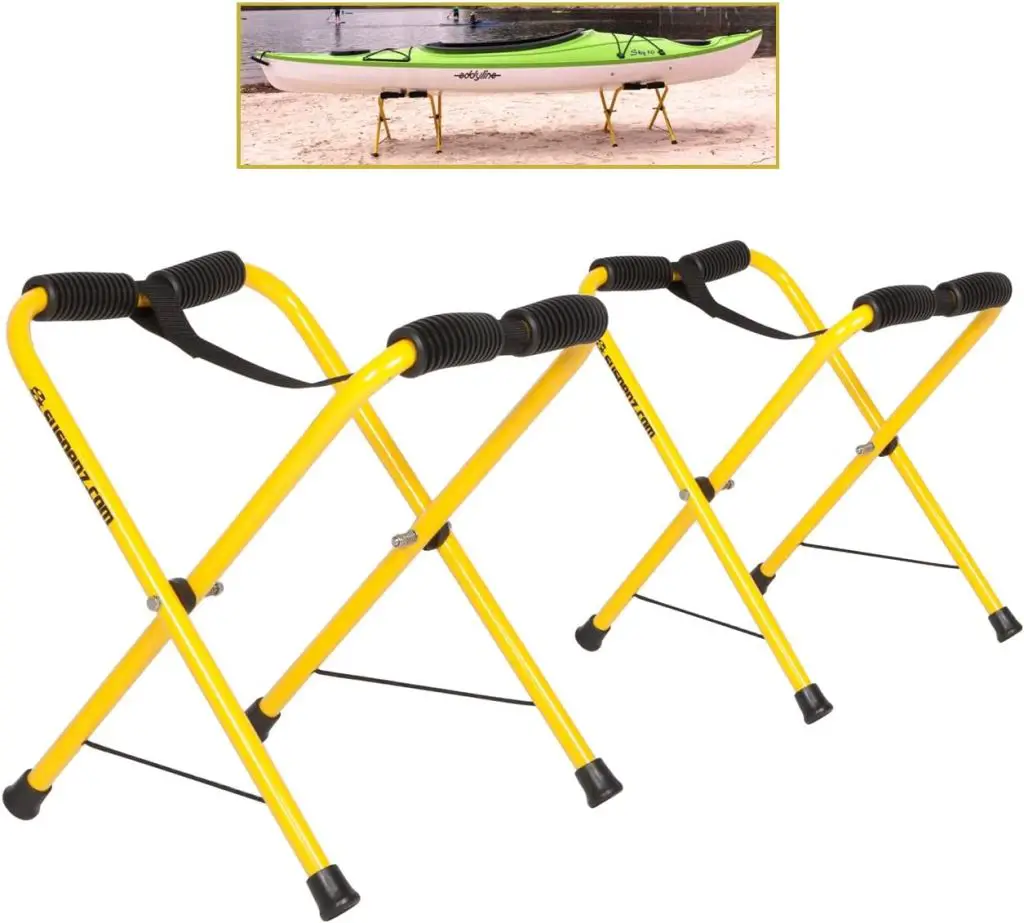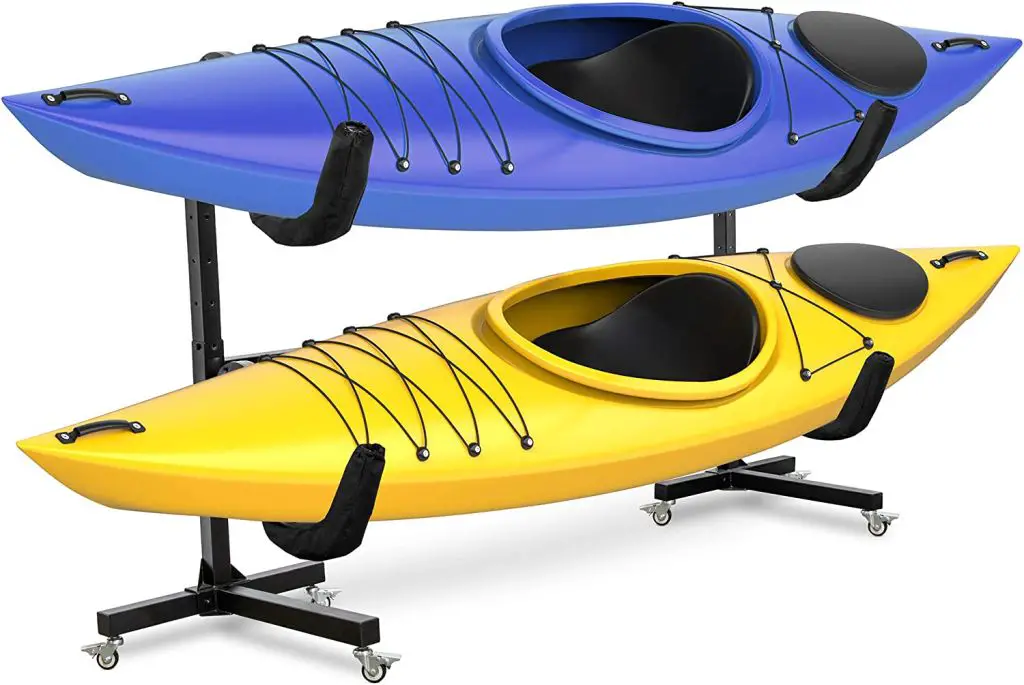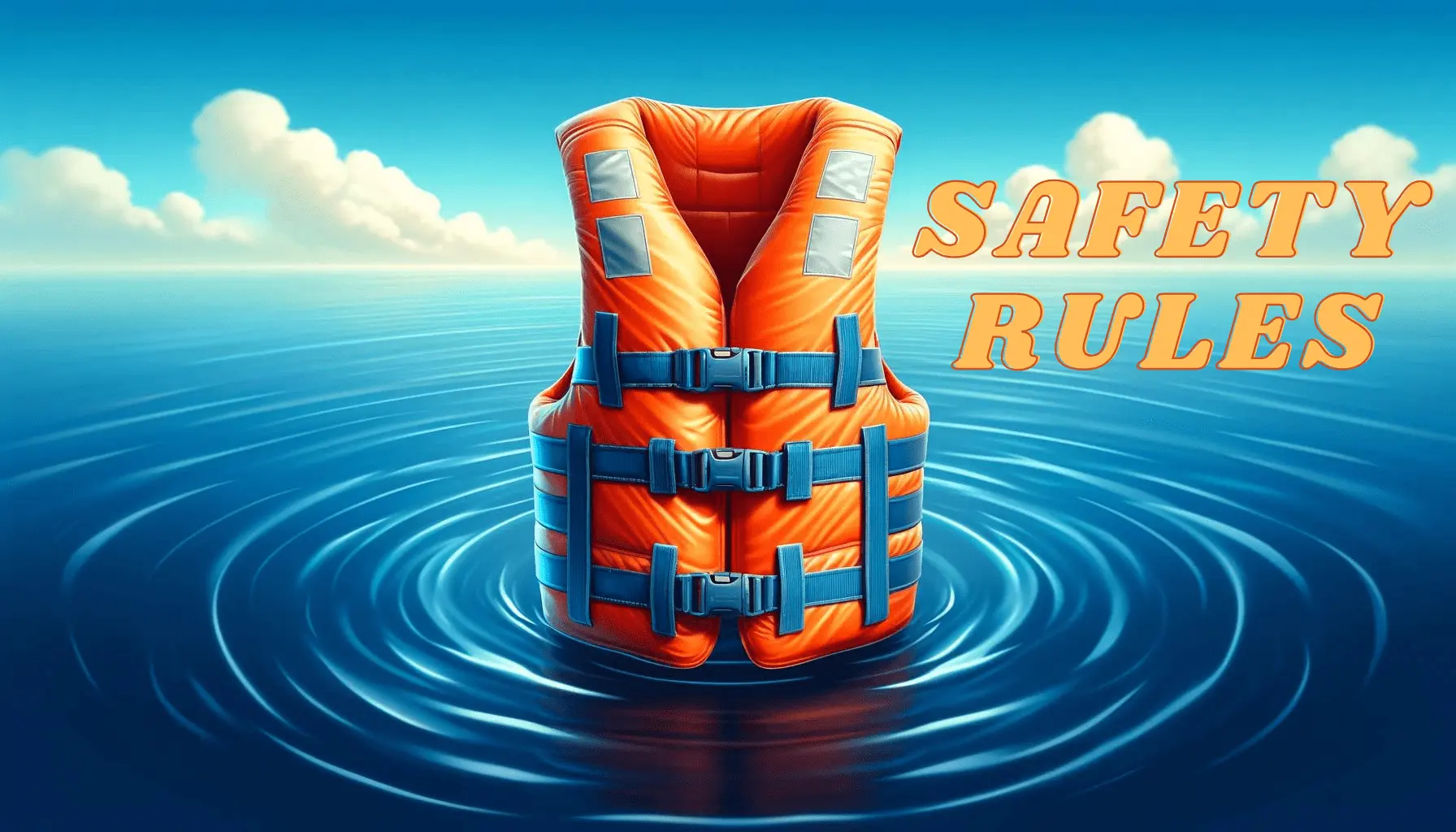Kayak storage is all about how and where you store your kayak. If you’re not careful with your kayak’s storage, you might end up in a bind.
Sure, it might seem like you can leave your kayak on the garage floor or outside for a few days and it won’t cause any harm, but the kayak’s unevenly distributed weight and the elements can do some serious damage over time. Plus, there’s always the risk of theft if you’re not securing it well.
If you stick around, I’ll show you several different kayak storage ideas to choose from, including both indoor and outdoor storage, depending on where you live and the type of kayak you own.
The question of kayak storage options to protect your investment is undoubtedly an important one. That’s why I’ve scoured the net to bring you these kayak storage ideas to try for your unique living situation.
Just ensure you take the kayak’s dimensions, storage space, and accessibility into account. That way, you can find the perfect spot to store your kayak and ensure it stays in tip-top shape for your next adventure.
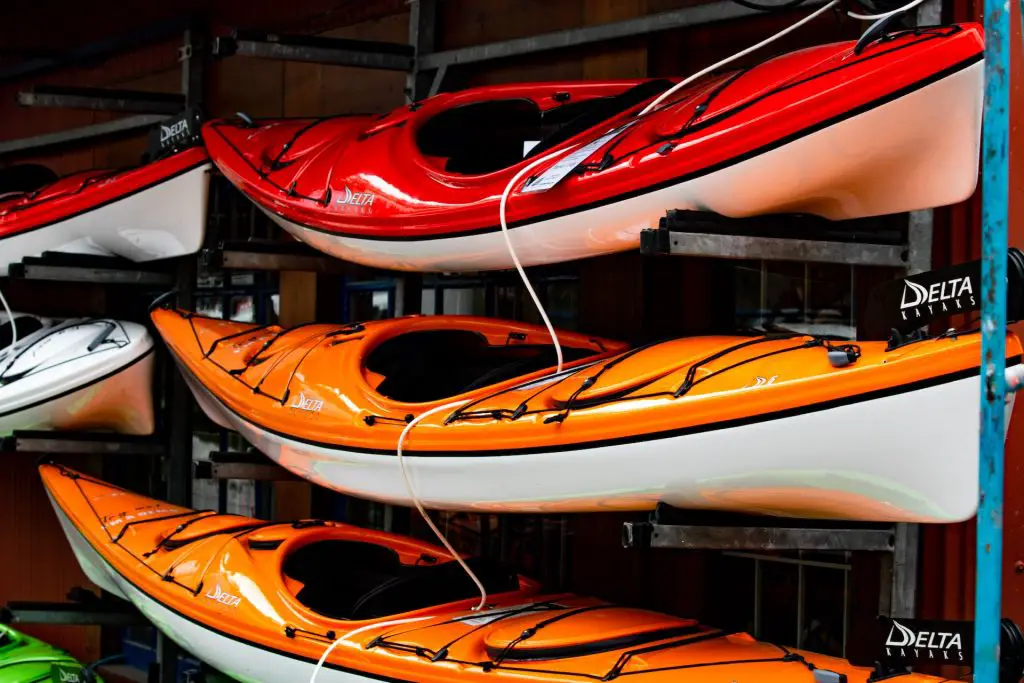
5 Indoor Kayak Storage Ideas
Always prefer indoor storage over outdoor storage for reasons I’ll expound on in this section. Here are some ideas you can choose from:
1. Wall-Mounted Racks
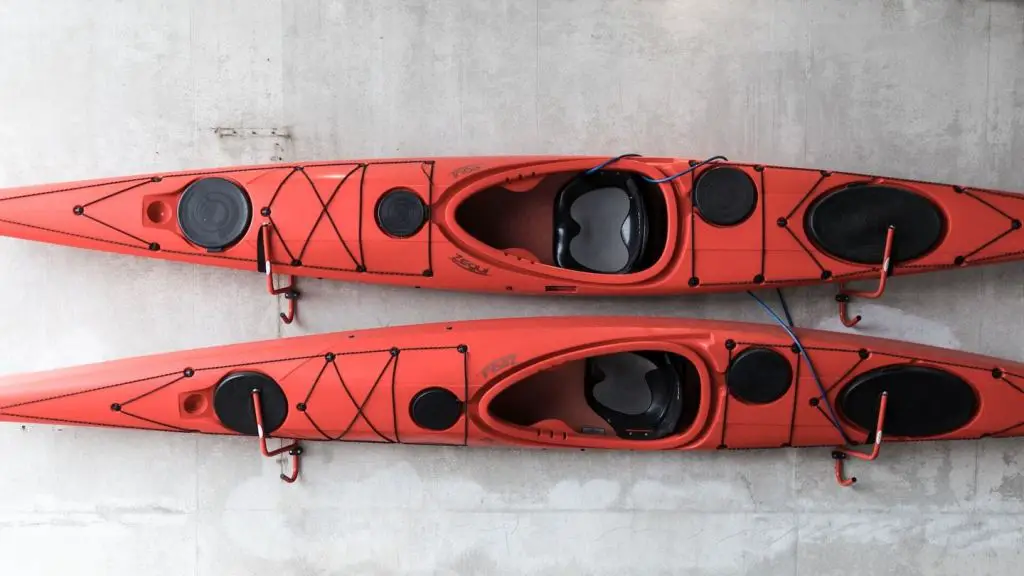
If you’re living in a small apartment and looking for a practical and stylish solution to store your kayak, a wall-mounted may be what you need. These versatile racks can be effortlessly installed both indoors and outdoors, offering you the flexibility to choose the most suitable location.
You can get creative with some DIY or buy ready to go models. And with options for both horizontal and vertical kayak storage, you can optimize your space and keep your kayak safely stowed.
Storing your kayak inside and off the ground will be easy with a wall-mounted kayak rack. By stacking a couple of kayaks horizontally and at a slight angle, you’ll be able to keep your storage area well-organized. The one downside is that it may take up a significant amount of wall space.
2. Ceiling Hoists
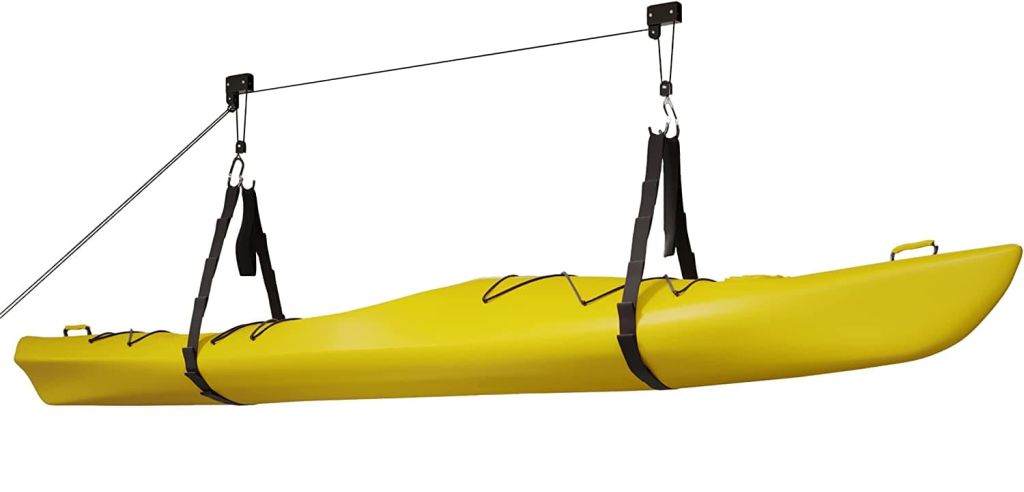
When you’re looking for an easy and affordable way to store your kayak indoors, consider a ceiling hoist! This type of kayak storage system utilizes a simple nylon rope and pulley system to lift your kayak up and out of the way, freeing up floor space.
Not only will a ceiling rack keep your kayak off the ground and within easy reach, but it also takes all the hassle out of lowering the kayak when you need it. However, you want to note that hanging storage systems can be tricky to install, so after you’re done, double-check that everything is securely fastened before hoisting your kayak up and then moving your stuff underneath it.
I must add that proper positioning of your kayak is needed for ensuring proper weight distribution, reducing pressure, and preventing any warping or damage to your watercraft investment.
So, take the time to position your kayak correctly to avoid deforming your ‘yak’s hull and having it look like a banana.
3. Kayak Storage Bags
Don’t leave your sit-inside kayak vulnerable to dust, dirt, or moisture— you can grab a storage bag for some added protection! These bags are crafted from tough materials like nylon, polyester, or canvas, and you can get them in various sizes to fit different kayak models.
Using a storage bag is a breeze. You just simply slide your kayak inside, zip it up, and you’re good to hit the road. Not only does it shield your kayak during car transport, but it also keeps your car’s interior free from any potential mess. They’ll act as a reliable shield against scratches and dents too.
The best part? These storage bags are highly portable and less strenuous when you need to move your ‘yak. So, if you’re planning a kayaking adventure far from home, you can try a bag.
4. Folding Stands
These are a practical and versatile storage solution for kayakers who are always on the go. These stands are great if you need a temporary storage option or want a spare set of racks for your shed.
They are lightweight, and you can readily find some made of rust-proof aluminum, making them durable and easy to transport. You’ll be able to accommodate any type of kayak hull and elevate the kayak off the ground to provide a stable and safe platform for washing or performing maintenance.
5. Freestanding Racks
Before considering a freestanding kayak rack system, the first thing to consider is whether you have enough floor space to accommodate it. These racks can take up quite a bit of space, especially if you’re looking to store multiple kayaks.
The good thing about freestanding racks is that they don’t require installation, which makes them quite portable. If you need to move a floor-standing kayak rack from one place to another, you can do so without the need for any mounting hardware. You can find ready-made racks online. Ensure it’s right for your specific model.
4 Outdoor Kayak Storage Ideas
Sometimes, you’ll find indoor storage may not be feasible for a full-sized hardshell kayak due to space limitations. Apartment dwellers can relate. In such cases, outdoor storage becomes a necessity.
Still, I maintain, it’s not the ideal solution, but if you absolutely have no other choice, you may want to consider these outdoor storage options:
1. Kayak Covers
Two things matter most for kayak storage: where you store it and how. I can’t stress enough that ensuring the protection of your kayak from the elements is crucial for its longevity. Even when you use it often.
UV rays, critters, and moisture can all take a toll on your ‘yak’s condition. That’s why investing in a reliable kayak cover is so essential. It doesn’t matter if you store your kayak indoors or outdoors.
Fortunately, kayak covers are easily accessible and dirt cheap, which makes it really easy to find the perfect fit for your specific kayak. So go ahead, invest in one, and give your kayak the TLC it needs for a long life.
2. Kayak Shelters
If you’re a kayaking enthusiast and you own a bunch of boats cluttering up your yard, a kayak storage shed could offer convenience. This could be the ultimate solution for folks craving a clutter-free garage and seeking to shield their beloved watercraft from the unforgiving clutches of Mother Nature.
But know that building a shed-like shelter is a little more advanced than making a simple rack, but it’s still a fun DIY project for any handy person that’s up for it. Gather some lumber, choose your favorite roofing material, and get building. You can find exact step-by-step instructions on how to do it in the video below:
3. Dockside Storage Racks
If you’re lucky enough to have easy access to the water and want to keep your kayak close at hand, dockside storage racks are the way to go. These nifty contraptions are installed right on the dock or pier, providing a secure spot to keep your kayak out of the water and ready for action.
Some possible drawbacks you may face with dockside storage racks are limited space availability, they don’t protect against UV that well, and the need for a stable and secure dock or pier to attach the rack to.
If you’re planning to use a dockside kayak storage rack, you most certainly have to invest in a quality kayak cover or tarp to protect your kayak from damage from the elements and little lifeforms that could enter it.
Also check your kayak regularly to spot signs of damage, wear and tear, and cracks, and consider moving it to a more protected storage location if you notice any issues.
4. Suspended Storage Systems
These nifty systems utilize sturdy straps or ropes to suspend your kayak from the ceiling, creating extra floor space for your other gear.
It’s like having a floating kayak art installation in your own home! Just make sure to install it properly and carefully and secure it tightly for a worry-free storage solution. Please don’t do this by yourself if you are not handy with tools.
3 DIY Storage Solutions
Not sure how you feel about DIY. Personally, I love it. Even if you’re not too excited about making your own storage systems, some of these are too easy and inexpensive that you may want to try them. Let’s get into the details.
1. PVC Pipe Racks
These babies are super convenient and versatile. You can opt to either set them up indoors or outdoors, whichever floats your boat. Plus, you can go for horizontal or vertical storage, depending on your space and style.
Just remember, though, that PVC pipe racks won’t shield your precious kayaks from the elements, so make sure you always keep ’em covered when using this storage option.
To make a PVC pipe kayak storage rack, you’ll need electrical PVC pipes, tee joints, and duct tape. Most people should be able to do this DIY project, as it is relatively simple to assemble and it’ll enable you to store up to four kayaks.
The beauty of a PVC pipe kayak rack lies not only in its functionality but also in its convenient nature. When the time comes for you to bid farewell to kayaking season or if you need to reclaim your space temporarily, this kayak storage rack can be disassembled and stored away without breaking a sweat.
It’s like the Houdini of kayak storage solutions—here when you need it, gone when you don’t. Watch the video below on the PVC pipe rack.
2. Wooden Storage Racks
If you want to optimize your garage space for storing your kayak and make it presentable as well, a ceiling-mounted storage rack is a choice you may want to consider. It’ll keep your kayak(s) off the floor and walls, freeing up valuable space for other items.
However, you need to note that installing a ceiling-mounted wooden rack may be a bit more complex and the need for additional hardware.
So, if you’re up for a DIY project, consider building a wooden rack mounted on the garage wall to keep your kayaks safely stored and out of the way. If not, you should be able to find ready-to-go racks online.
3. Vertical Storage System
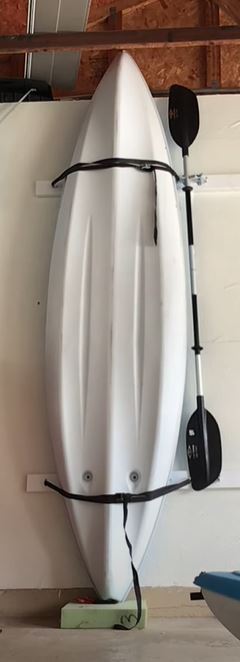
Vertical kayak storage may not be the first option you want to try, but it’ll work fine as long as you ensure proper support for the kayak’s stern and lift it off the ground. But before opting for vertical storage, check if your ceiling provides enough clearance, especially if you have a longer kayak.
When you’re ready to set up vertical storage for your kayak, there are some handy tips to practice for a secure and convenient setup. Depending on the kayak type, positioning your kayak with the cockpit facing outward allows for easier access.
Plus, it dumps pressure points. It’s also good practice to provide raised stern support to maintain stability and protect your kayak from any potential damage.
For added security, I’d advise that you lean the kayak slightly towards the wall at a slight angle to ensure it stays in place. You can use reliable pegs or hooks that prevent the kayak from tipping or falling sideways when it’s hit. And, of course, always remember to secure the kayak with safety straps or ratchet straps and keep it firmly in position.
Tips For Safe And Effective Kayak Storage
Leaning a kayak against a wall or storing it on the ground can often cause uneven weight distribution, which in turn leads to hull deformation, what’s known as oil canning, cracks, instability, and other common issues over time.
Even more, kayaks require protection from the elements, seeing as temperature changes, UV rays, mold, and mildew can degrade the kayak’s integrity and make it unsightly. That’s why you could use the tips below, especially if you’re new to this.
Proper Cleaning And Maintenance
Before storing your kayak, even if you’ll use it the next day, always inspect it for any dirt, grime, or damage, such as cracks or dents, and repair them. Yes – this is the time to do it. Not before you leave for your kayaking trip.
The best way you can maintain your kayak while it’s in storage is to clean it thoroughly before putting it away. Use mild soap and lots of clean water. Be sure to clean both the outside and inside, then dry it completely to avoid moisture buildup.
A clean kayak will be easier to take out of storage, and you will be less likely to discover nasty mold or mildew growth once the storage season is over.
Avoiding Damage During Storage
Experienced kayakers and newbies alike should try to avoid certain common mistakes. For example, hanging the kayak by its handles or placing heavy objects on top of it. This, as I’ve mentioned earlier, can cause your ‘yak to warp or deform over time.
Instead, consider using foam blocks or cradles to support the kayak’s weight and keep it stable. It’s also important to make sure that the kayak is never exposed to direct sunlight or extreme temperatures for long, as this will harm the hull and other parts of the kayak.
Also, if you’re doing vertical storage, keep it at an angle and strapped firmly so you don’t risk having it fall over.
Seasonal Storage Considerations
Freezing temperatures or fluctuations in temperature can cause the water left inside the kayak to expand and contract, which will lead to cracks, dents, and other forms of damage.
If you store your kayak outdoors in freezing temperatures, the water inside will go through changes that won’t help the longevity of your ‘yak.
UV rays from the sun can also cause damage to your kayak over time. Prolonged exposure to sunlight can cause fading and discoloration of the kayak’s material. It can also cause the material to become brittle and prone to cracking.
This is why I insist that it’s important to store your kayak in a shaded area or cover it with a tarp or protective cover when it’s not in use.
Summary
Whether you’re a seasoned kayaker or a casual paddler, proper kayak storage is the key to keeping your favorite watercraft in top shape. Fortunately, there are plenty of storage options to suit your specific kayak type mentioned above.
If you have limited indoor space or require outdoor storage solutions, you can try some practical suggestions in the post. From wall-mounted racks and ceiling hoists to kayak storage bags and freestanding racks, there’s something for your kayak type.
Still, there’s more to it than just simply finding the right storage system—you have to regularly maintain your kayak before and after storage.
Always give it a thorough cleaning, inspect it for damage, and ensure it’s dry before storage. Try to avoid some common pitfalls like hanging your ‘yak by the handles or subjecting it to uneven pressure and deformation like, say from leaving it on the floor resting on its hull.
Instead, keep it in a shaded area and always cover it with a protective tarp when it’s not in use. And that’s it, happy kayaking!
